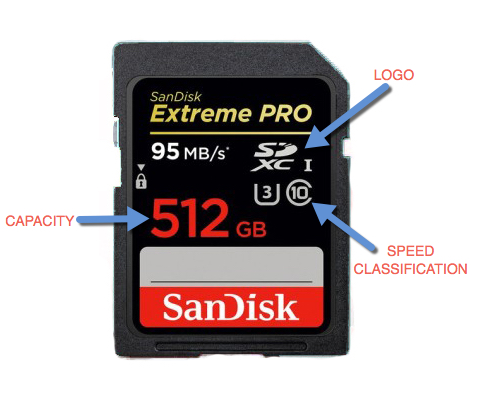Understanding Memory Cards
In modern cameras two basic types of memory cards are used – SD (Secure Digital) cards and CF (Compact Flash). The first can be found in a wide range of devices from compact cameras to semi-pro reflex cameras. Professional photographers use the second variant, but most likely it will be soon replaced with more modern nowadays SD cards.
Let's talk about Secure Digital cards, as they are more widespread. For CompactFlash, all recommendations are the same. This format is developing rapidly, and now basically the third generation cards are presented: SDHC (Secure Digital High Capacity) up to 32GB and SDXC (eXtended Capacity) 64GB and 128GB. It should be noticed that SDXC was released in already far 2009, however, even nowadays we can find cameras that don't support cards which capacity exceeds 32GB. Apart from the above mentioned, with the help of adapters miniSD or microSD cards can also be installed into a standard socket. However, I don't recommend to use this variant due to low mechanical security.
In general, memory cards differ in capacity and data transfer rate. Usually, 4GB or 8GB is enough, if you shoot in RAW you may require more space, the same is with video, 30 min in the highest quality takes about 2GB. Approximately in modern cameras, a common JPG image in the highest quality takes up to 10 megabytes andRAW about 20.
I always recommend splitting the capacity required for the shooting at least twice. If you are planning to shoot 16 GB of material during your trip, then it's better to take two cards 8GB each. Unfortunately, in spite of the overall safety, memory cards can break in the most critical moment. If you save your shots on different media, you will rescue at least some photos even if one of the cards breaks down. And of course, you should not forget about additional storage, when you have an extraordinary photo session.
One more tip, before the shooting, after you have saved all data to your computer, make sure you have formatted a card in your camera. This will help to avoid all potential compatibility problems, and sometimes detect some card troubles before the shooting.
The second characteristic is the recording rate, but you shouldn't blindly pursue high rates. A camera stores a taken picture to the internal disk storage when a buffer is full, or a user doesn't take pictures for some time the information is moved to the card. Bearing in consideration above mentioned facts it can be said that high speed is required only when you make long fast series of shots in RAW. You will also require high recording rate when shooting a video, but here you don't need extremely high rates.
For more information please visit the SD Association.
Above is placed a table displaying data transfer rates and identification notes for SD cards. For typical shooting 2 Mb/s is enough, but now they are almost out of use. You need higher speed if you shoot video - 4-6 Mb/s, if you shoot dynamic scenes with the significant amount of motion in the shot, then it's better to hedge your bets and take a 10Mb/s card. As for today, it's the maximum for common SD cards, they are marked as the class 10 or UHS-I. Little by little new more speed models appear, but still, it makes no sense to use them in cameras.
Pay attention that various notes such as Extreme, Professional, and High Speed can mean nothing. One more or less precise characteristic is the speed class. One more important moment is that large and well-known manufacturers such as Transcend, Kingston, SanDisk usually adhere the declared speed characteristics. If you are buying products of any relatively known brand, it is likely to get a slower card than specified in the description. In such cases, it is better to study reviews of specific models or take a more powerful card.
Finally, I want to mention Eye-Fi cards. These are wireless SD Cards with built-in wi-fi. They allow you to transfer photos from your camera using a wireless network. On one hand, it is more convenient, on the contrary, they drain a battery heavily. They don't provide any additional functionality apart from transmitting files, namely you won't be able to operate the camera through wi-fi. In my opinion, the only reasonable purpose of using them is the fast transfer of images during shooting, in case you don't have a computer at hand. This variant may be rather useful for professionals in some cases, if not one limitation, you are not able to send RAW files only JPG.
I hope I've managed to describe all aspects in detail, but if you have any questions, ask them in the comments.












